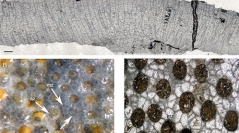

 Geodiversitas
32 (2) - Pages 177-199
Geodiversitas
32 (2) - Pages 177-199Bryozoans are among the most abundant fossil groups in the cool water limestones that characterize the uppermost Katian (Upper Ordovician) of Southwestern Europe and North Africa. The Cystoid Limestone Formation, the representative unit of those widespread rocks in the Iberian Chains (NE Spain), yields one of the most diversified bryozoan faunas of the whole area. Herein the first systematic description of the trepostomate family Monticuliporidae is undertaken, this is one of the most diverse families within the associations collected. Four species of the genera Monticulipora and Prasopora are described, including the new species Monticulipora cystiphragmata n. sp. and Prasopora spjeldnaesi n. sp., and an indeterminate Monticuliporidae. Monticulipora and Prasopora have shown to be very similar genera, with several species that are difficult to distinguish between them. Their diagnoses include common features such as the wall microstructure, density of mesozoecia, and number of acanthostyles. Herein a new generic diagnosis of Monticulipora is proposed, putting special emphasis on the shape and distribution of cystiphragms. The species Monticulipora kolaluensis is identified for the first time out of Siberia. Although the record of these new taxa can indicate a certain isolation of the Iberian Chains region within the North Gondwana platform, the occurrence of Prasopora carnica shows a relation to the neighbouring Carnic Alps (Italy and Austria).
Bryozoa, Trepostomata, Monticuliporidae, Upper Ordovician, Cystoid Limestone Formation, Iberian Chains, new species